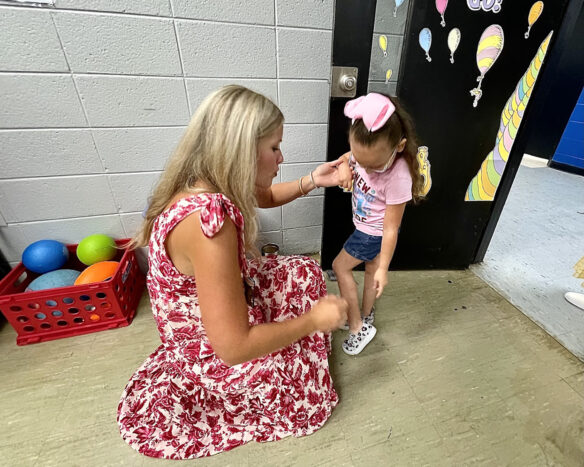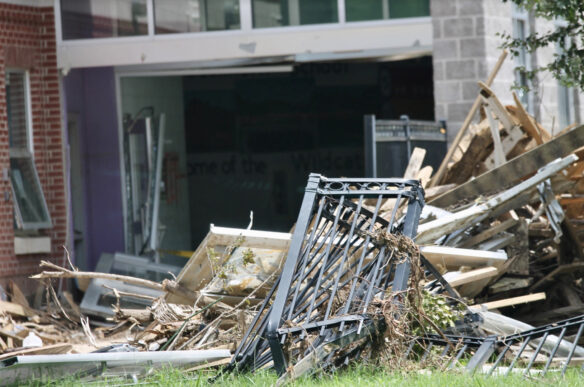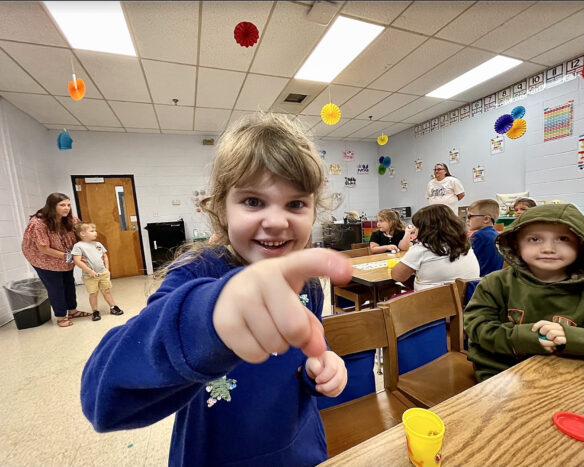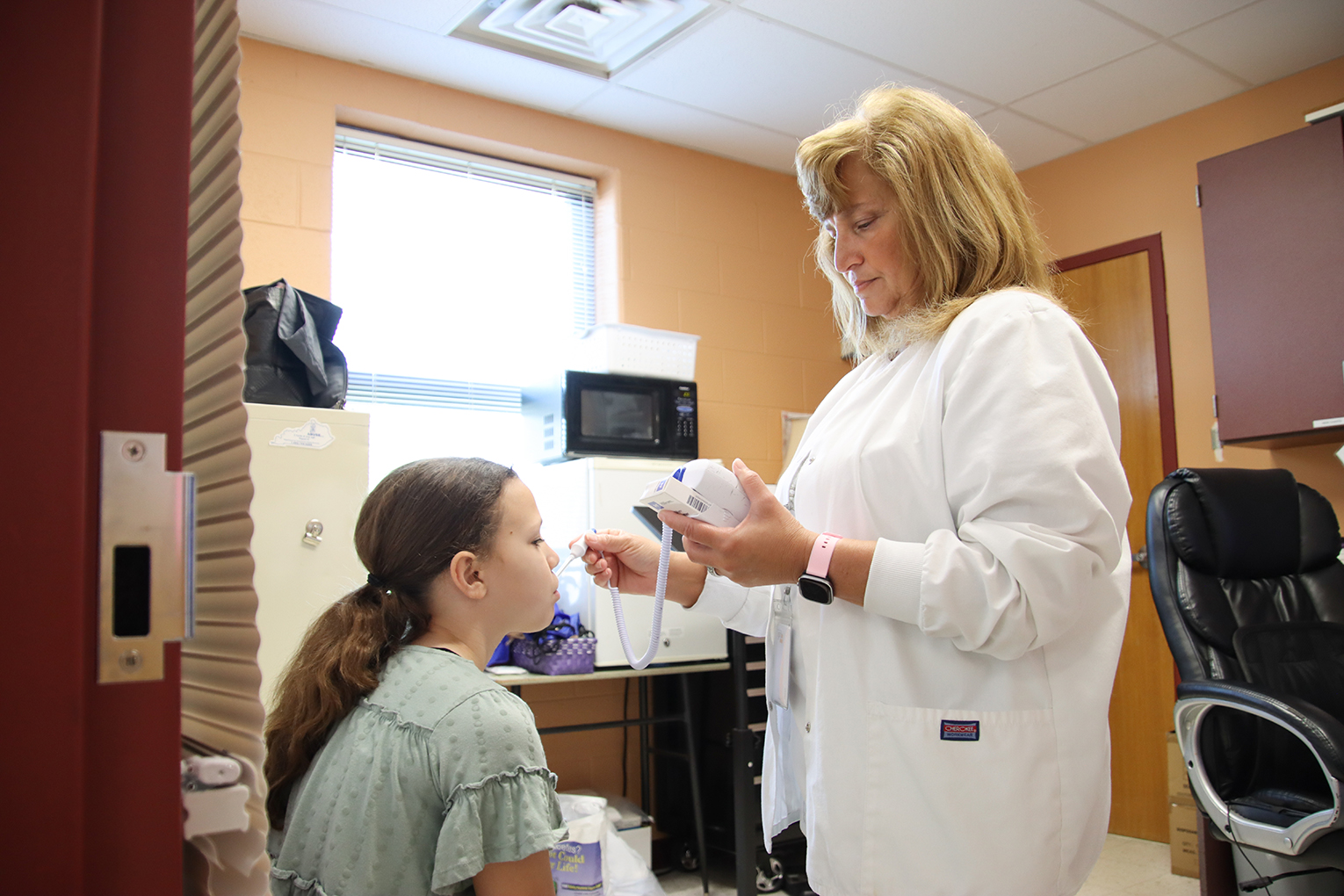
Courtney Hall, 2nd-grade teacher at Robinson Elementary, greets a student on their first day of school at the A.B. Combs campus. Hall’s focus is now on building stability for her students. Photo by Caleb Bates, Aug. 31, 2022.
As floodwaters began to quickly overtake his community on July 28, Jamie Fugate found himself some three hours away getting panicked phone calls.
For Fugate, a principal in Perry County, the Kentucky Association of School Administrators (KASA) conference in Louisville ended abruptly and ahead of schedule.
“My wife called me around 2:00 that morning. She said water was around our house. Then she called about 15 minutes later, and she said it was in our home,” said Fugate, principal of Robinson Elementary. “We had to save my family out of a second story window.”
Fugate’s home has now been stripped to the studs and his school building deemed a total loss.
Fugate’s story and that of others in eastern Kentucky school districts during the flooding show the grit and resilience that part of the state has long been known for. Far removed from major cities and resources, and deep in the mountains in coal country, many in eastern Kentucky have learned to rely on themselves, and each other. Families, communities and schools pulled together to survive.
In a different community in Perry County, Kylie Napier, a senior at Buckhorn School (Perry County), lost her home that night.
“We stayed near (our property) for about 24 hours. It was still raining, and we were trying to get out,” she said.
She found her father – who was looking for her – and safety.
“The water finally came down, and my dad walked our holler, miles down the holler, to come get me. Then we walked back out. We were climbing over mudslides, greeting people … everybody was trying to get out. There was no way out of there,” Napier said.
Courtney Hall, a 2nd-grade teacher at Robinson Elementary who talked with Kentucky Commissioner of Education Jason E. Glass during his visit with eastern Kentucky school districts on Aug. 30 and 31, said her focus was not on the damage to the school building where she teaches, but rather on the families and students she serves.
“The first thing I thought about when I saw (the building) was ‘What about our kids?’ We have so many kids that live on the riverbanks. So I knew that if it had gotten that high in the school, then we had kids who were homeless,” she said.
Judy Eversole, Family Resource/Youth Service Center coordinator at Buckhorn School, continued to serve her community without a building. She started by focusing on immediate needs, like clothing, food and hygiene products.
She has now shifted to long-term needs, working to establish stability in her students’ lives.
“I still have a lot of families who need a lot of work done, like in their homes. And that’s going to be my next focus,” she said.
The flood recovery effort in Perry County is expected to take years. When Hall left the school building in May, she said she could not imagine the scene she returned to after July’s flooding.
An educator like generations of her family before her, Hall had planned to inherit a classroom from her aunt, who retired after four decades of service in Perry County.

Piles of debris lined the Buckhorn School campus for weeks after the flooding. Many of the building’s doors were ripped from their hinges, its fence pulled from its posts and classroom items caked in mud. Photo by Caleb Bates, Aug. 31, 2022.
“Mud up to your knees, everything in my classroom was overturned, gone. We dug through the mud to try to get pictures, just anything,” she said. “I graduated 8th grade there, taught there, grew up in that building. To see it full of mud and everything you’ve worked for and everything the people that you love have worked for, underwater … it was heart-wrenching.”
Perry County Superintendent Jonathan Jett aimed to provide students with some sense of normalcy at school, but with damages to the facilities, he was unsure how to go about it.
Jett said one district leader mentioned the idea of using the old A.B. Combs Elementary campus, a building empty for the last half-decade after school consolidations. The building was once the largest elementary school in Perry County and held more than 700 students.
“We drove down there, walked around the building, looked at things. I said, ‘This might just work,’” Jett said.
However, the school required repairs before it could be used.
“We have had volunteers, our classified staff … has come in and worked even when they didn’t have to. … It was so important to keep everyone together, we would have done anything,” Hall said.
One wing of the school is painted blue, for Robinson. The other is painted purple, for Buckhorn. The building opened for the new school year on Tuesday, Sept. 6, nearly one month from the district’s planned start date of Aug. 10.
“It could have been so easy for Superintendent Jett to say, ‘You students go here, other ones go here,’ but no. … He took the money and time out to build here, to redo it, help us out and come together as one,” said Dalton Day, a senior at Buckhorn School. “The building might be different, but we’re together.”
While Hall’s inherited classroom at Robinson Elementary is unusable due to flood damage, she inherited a classroom at the A.B. Combs building.
“My aunt came in to help me decorate, and she said, ‘You know this is your grandpa’s room, right?’ and she asked if I had picked it. ‘Nope, it’s just a major coincidence,’” Hall said. “To think, the room I’m in was my grandpa’s room. …
“He taught for close to 40 years in the county,” she said. “He finished out his career here.”
Emily Amis, a senior at Buckhorn School, had looked forward to her last year.
“It means a lot to be here together in this building. This is my school, our school. … We’re family. It means everything. Some of us have been together since 3rd grade, kindergarten, preschool,” she said. “I couldn’t have made it anywhere else, especially it being my last year, my senior year. It means everything.”
For Hall, a building or facility does not make a school.

Students from Buckhorn School and Robinson Elementary are carrying out their school year at the A.B. Combs Elementary campus, which had been shuttered for the last five years. Photo by Caleb Bates, Aug. 31, 2022.
“I always say that it’s a public school but really, it’s a community school,” Hall said. “It’s truly all about the community.”
Though the schools faced difficult times preparing for this school year, leaders say their work has paid off.
“To hug those kids, or give them a fist bump, or shake their hands when they get off the bus, it’s all been worth it,” said Tim Wooton, principal of Buckhorn School, who was at the conference in Louisville along with Fugate when the flooding occurred.
District leaders plan to use the A.B. Combs campus for the remainder of the school year. As cleanup and rebuilding work continues, they hope to have a long-term solution to address the schools’ losses. For now, though, the schools are making a new home for their students.
“It’s been tough, but we have to move on,” Fugate said. “We rolled up our sleeves, and we made a home out of this building.
“We are moving forward.”




Leave A Comment